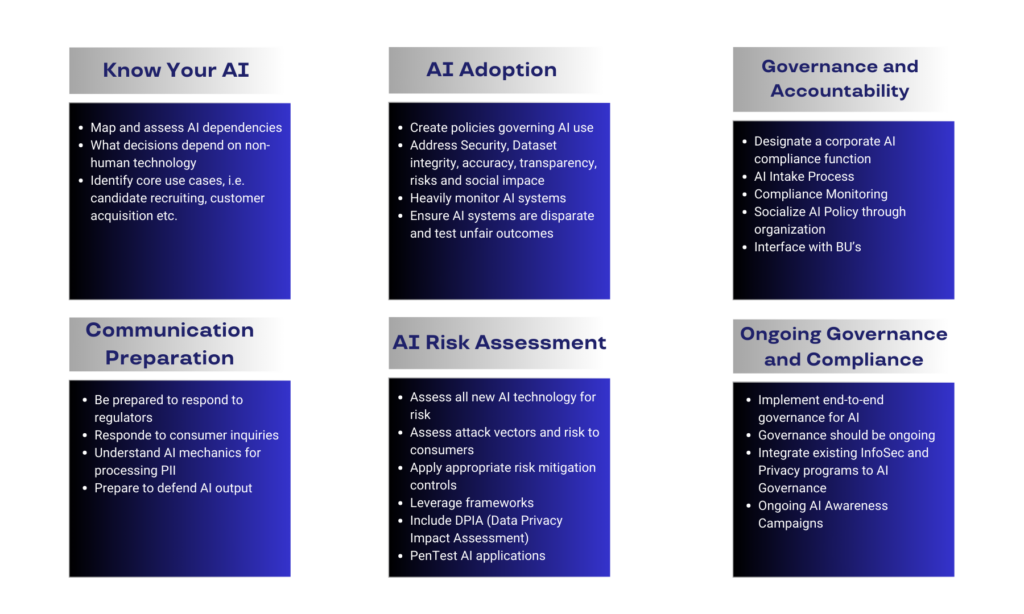There’s no mistaking that AI is an inevitable future for most, if not all, large companies and organizations. “If” turned to “when” once generative AI was released to the world, and companies have found themselves on the cusp of unprecedented technological transformation. No matter what capacity you choose to use it in – preparing your company and staff to safely and effectively implement AI technology is of critical importance.
AI readiness refers to the strategic and operational state of a business or organization in terms of its preparedness to effectively adopt, integrate, and leverage Artificial Intelligence (AI) technologies in its processes, decision-making, and overall operations. An AI-ready enterprise possesses the necessary foundation and resources to seamlessly incorporate AI solutions, adapt to changes, and maximize the potential benefits that it can offer in terms of efficiency, innovation, and competitive advantage.
AI readiness includes having a sustainable and visible program that addresses:
Data Privacy
Ethics
Laws & Regulatory Compliance
Security
Trust
Any new technology can bring with it new threats, and AI is no different. In fact, it presents quite a few challenges that will need to be addressed and monitored by your organization before, during, and after implementation.
Phishing and Social Engineering
Deception and Trust Rot
Data Leakage
Prompt Injection Attack
Tuning Data Poisoning
Shadow LLM
Model Poisoning
Software Vulnerabilities
Bias Behavior
Lack of Access Control
Model API Attack
Rogue Agents
There are 5 recommended key areas to focus on when implementing AI applications and systems:

Improve security by having a formal organization whose sole purpose is to manage and ensure that your business is following and adhering to the AI policies and controls that have been put in to place.
Increase trust by evaluating the output that comes back to the user through data corpus tuning, refine your hallucination detection, and ensure all AI applications are providing something that enables trustworthiness (i.e. certifications, SOC, ISO etc.).
AI Intake Process
BU AI Design/Intake > AI Workgroup > Project Analysis > AI Readiness Recommendations > Collaborate and Decide > AI Governance Integration
AI intake needs to follow a well-developed plan utilizing an AI Workgroup comprised of various SME’s in critical areas of expertise to ensure a structured and formalized decision-making process. Important areas of representation are: Security, IT, Privacy, HR/Ethics, Legal, and Risk Management.
To make informed decisions regarding deployment, it is helpful for your group to understand the architecture and design behind the AI technology. Each SME should review specific areas relevant to their expertise to provide the most accurate input and feedback possible.
At the heart of AI Readiness is risk assessment. Using the 5 recommended key areas of focus, your team should develop a well-rounded systematic and comprehensive evaluation of potential risks, challenges, and vulnerabilities associated with the development, deployment, and operation of AI systems.
All areas will collaboratively decide to “yay” or “nay” the AI application under review. This decision will ultimately be based on risk. Should they find the system ill-prepared for deployment, it should be sent back to the intake phase to undergo mitigation and redesign.
Compliance enforcement for AI is rapidly evolving, so governance integration is of vital importance. Employ a guidance group, whether internal or external, to ensure proper policies and controls that are recommended to treat risk are being followed and applied for AI use. You can help protect your organization and clients from potential legal and financial risks by obtaining internationally-valid certifications such as those offered by Exin.
Readiness “To-Do’s”

Understand what your business is trying to achieve through the use of AI.
Document policies for others to follow to ensure safety, trust and ethics are being followed.
Isolate as much as possible to eliminate concerns around spending money on, or developing controls for, non-AI related efforts.
Have an apparatus within the company with a high level of visibility to monitor compliance.
Minimize liability through socializing your AI policies. Get to know what other areas are doing and what their demands are to encourage inter-departmental assistance when deploying AI technology.
If/when a compliance regulator asks what you have in place to defend your actions and output, make sure you have defined, and have visibility around, AI mechanics for processing PII (Personal Identifiable Information).
As stated, risk assessment is #1. Whether through a third party or internally, it is critical to assess what you’re doing with AI technology within all applicable environments.
Ongoing governance and compliance will be expected of all companies deploying AI systems. Make sure your organization is ready by implementing a process to continually assess and employ someone internally who can continually monitor new attack vectors.
Additional actions advised or required will include:
AI Frameworks and tools (i.e. OWASP AI Top 10, NIST Risk Management Framework, AI Impact Assessments)
Data Privacy Impact Assessment (DPIA)
Penetration Testing for all local and 3rd party AI applications
Save money and resources by integrating any existing privacy and infosec programs with AI development programs, and ensure company-wide awareness and compliance by inserting AI threat awareness in to current security training.
Sources: Cloud Security Alliance (CSA), Sean Wright (“AI Readiness Deployment Strategy” CSA AI Summit 2023)



